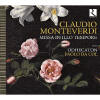Texte paru dans: / Appeared in:
*

International Record Review -
Pour
s'abonner / Subscription information
Ricercar
RIC322

5400439003224 (ID206)
Consultez toutes les évaluations recensées pour ce cd
~~~~ Reach all the evaluations located for this CD
The Italian chamber choir Odhecaton takes its name from Petrucci’s legendary 1501 publication of vocal polyphony; its discography is already reasonably substantial, with plenty of awards under its belt. Here it juxtaposes Monteverdi’s deliberately old fashioned tribute to Renaissance polyphony with motets in his then cutting-edge early Baroque style — as indeed did Monteverdi himself when he published the Mass alongside a Mass for four voices and the smaller sacred works now collectively called the 1610 Vespers. (Aptly enough, given Odhecaton’s core repertoire, it also performs the Gombert motet on which the Monteverdi Mass is based. When one reads the words it is hard not to be struck by how un-Marian a text it is for Monteverdi to have chosen it as the basis for a work published alongside the very Marian Vespers.)
Odhecaton is an all-male choir with countertenors on the top line. It observes the ‘ chiavette’ convention (under which works such as this Mass, written with the lowest part in the baritone clef, would be transposed down a fourth, which of course has made for no little controversy in performance of those 1610 Vespers) , as SATB choirs such as Philippe Herreweghe’s or Masaaki Suzuki’s tend not to do, and the sound is all the richer for it. These are consistently eloquent performances; the sound has an appealingly direct roughness, agreeably gravelly in the bass, rather than an unearthly purity. The countertenors might for some ears occasionally be a little astringent of timbre (somewhat in the manner of Hilliard Ensemble recordings of old) but the taste is worth acquiring. The Monteverdi works are performed with continuo participation, discreet for the Mass and rather more flamboyant for the Monteverdi motets, in which, of course, the continuo is indispensable.
Odhecaton recorded this disc in an authentically Monteverdian location, the Basilica of Santa Barbara in Mantua. Director Paolo Da Col has chosen not to perform all the works from the same position in the building. The Mass and the Cantate Domino are performed from two separate galleries: the gallery of their first choice was apparently too small for the 16 singers employed here (which does prompt one to wonder if these forces might be a little more generous than Monteverdi’s own) . The more intimate motets are performed from the ‘chantry’; the resulting acoustic is intimate, perhaps even a little on the dry side. The two Salve Regina settings and the Regina caeli here receive their first recordings and indeed have only recently been ascribed to Monteverdi by the musicologist Luigi Collarile . (The Regina caeli provides the only female voices on the disc — and one of those is a rather low contralto.)
Giaches de Wert was also associated with
the Mantuan basilica — he was court composer at the beginning of
Monteverdi’s association with the court as a performer. Vox in Rama and
Adesto dolori meo are both memorably chromatic in the late-Renaissance
style; Ascendente Jesu adds a variety of madrigalian syncopations to
portray the storm at sea which terrifies Jesus’s disciples. The association
of de Wert with some of Monteverdi’s most backward-looking music is
effective, serving to remind us of the sixteenth-century roots of a composer
best known for his revolutionary feats at the very beginning of the Baroque.
These are fine performances in a rich tonal palette, from a group worth
following.
Fermer la fenêtre/Close window
Cliquez l'un ou l'autre
bouton pour découvrir bien d'autres critiques de CD
Click either button for many other reviews


